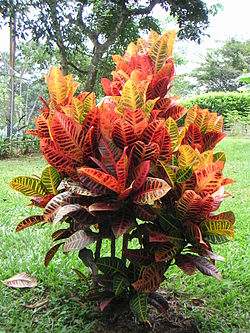| Codiaeum | |
|---|---|
 | |
| Codiaeum variegatum | |
| Scientific classification | |
| Kingdom: | Plantae |
| Clade: | Tracheophytes |
| Clade: | Angiosperms |
| Clade: | Eudicots |
| Clade: | Rosids |
| Order: | Malpighiales |
| Family: | Euphorbiaceae |
| Subfamily: | Crotonoideae |
| Tribe: | Codiaeae |
| Genus: | Codiaeum A.Juss. |
| Synonyms [1] | |
Codiaeum is a genus of plants under the family Euphorbiaceae first described as a genus in 1824. [2] [3] It is native to insular Southeast Asia, northern Australia [4] and Papuasia. [1] [5]
They are shrubs with leathery leaves and often confused with the genus Croton . Some species, especially Codiaeum variegatum , are cultivated as houseplants. [6]
- Species [1]
- Codiaeum affine - Banggi
- Codiaeum bractiferum - Lesser Sundas, Maluku
- Codiaeum ciliatum - Philippines
- Codiaeum finisterrae - NE New Guinea
- Codiaeum hirsutum - Philippines
- Codiaeum ludovicianum - Louisiade
- Codiaeum luzonicum - Philippines
- Codiaeum macgregorii - Philippines
- Codiaeum megalanthum - Philippines
- Codiaeum membranaceum - Cape York Pen
- Codiaeum oligogynum - New Caledonia
- Codiaeum palawanense - Palawan
- Codiaeum peltatum - New Caledonia incl Loyalty
- Codiaeum stellingianum - Kai Is, New Guinea
- Codiaeum tenerifolium - New Guinea
- Codiaeum trichocalyx - Luzon
- Codiaeum variegatum - Indonesia, Philippines, New Guinea, Bismarck, Solomon, Fiji
- Formerly included [1]
moved to other genera: Austrobuxus Baloghia Blachia Fontainea Sphyranthera Trigonostemon
- C. alternifolium - Baloghia alternifolia
- C. andamanicum - Blachia andamanica
- C. aurantiacum - Trigonostemon aurantiacus
- C. balansae - Baloghia balansae
- C. brongniartii - Baloghia brongniartii
- C. bureavii - Baloghia bureavii
- C. carunculatum - Austrobuxus carunculatus
- C. deplanchei - Baloghia deplanchei
- C. drimiflorum - Baloghia drimiflora
- C. inophyllum - Baloghia inophylla
- C. lucidum - Baloghia inophylla
- C. lutescens - Sphyranthera lutescens
- C. montanum - Baloghia montana
- C. pancheri - Fontainea pancheri
- C. pentzii - Blachia pentzii
- C. umbellatum - Blachia umbellata